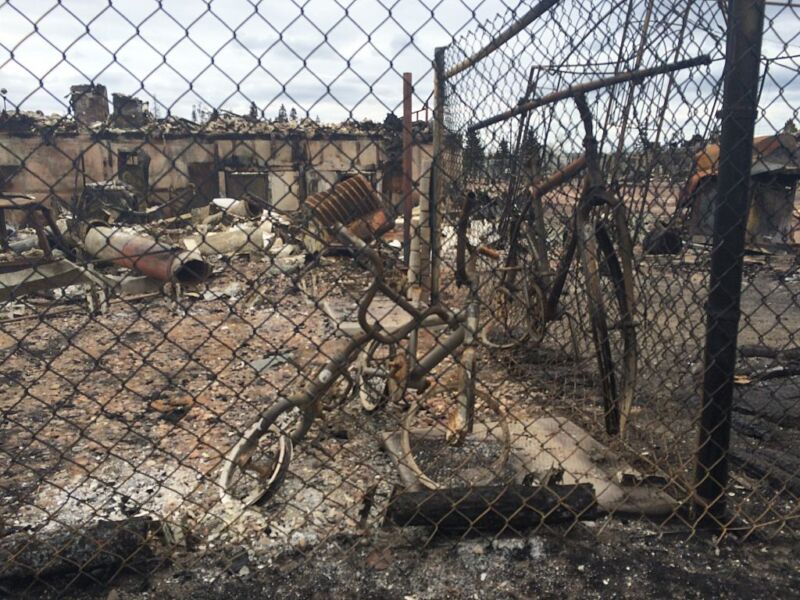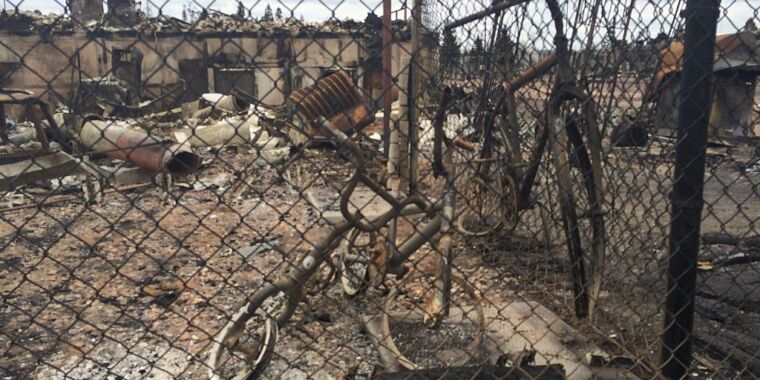
At noon on May 3, the fire chief in the oil town of Fort McMurray was on TV telling everyone that the situation was under control and to stay at work and school and go to Little League or whatever as usual. He’d been watching the fire for a few days, but in the spring they just went about their business in Alberta; after all, it was wildfire season. At 2:05 p.m., evacuation orders began to come through. By 10 o’clock that night, much of the city that had not yet burned was on fire.
The combination of extremely, record-breaking high temperatures (91°F) with extremely, record-breaking low humidity (15 percent), wind, and tons of dry fuel made for perfect fire weather. While this explosive combination used to be unattainable, it is becoming more common around the world, including in areas where forest fires have never occurred.
After destroying the city and the mines that fed everything in town, the Fort McMurray Fire continued to burn for 15 months, until August 2, 2017. Fire again tells his story, trying to put it in the context of our warming world.
Part One: Origin Stories
The book’s biography and analysis of the fire begins with a background on bitumen (pronounced BITCH-amin), sand mixed with tar. It doesn’t burn. It was traditionally used as a glue, for example in the Tower of Babel (Genesis 11:3). But Fort McMurray was built to mine it and turn it into power. Vaillant writes that this requires so much work that the only way it can be made remotely profitable as an energy source is through the conspiracy of heavy government subsidies and an almost complete lack of regulation, oversight or penalties for emissions. Alberta was thrilled to provide all of this.
Vaillant then describes how the petroleum industry is just the latest in a list of colonial, capitalist, extractive enterprises that have plagued Western Canada. In the 18th century, the Hudson’s Bay Company made beavers all but extinct because European men liked their pelts like tophats (they were shiny and water-repellent). In the 19th century, sea otters were hunted to near-extinction as Chinese men traded their waterproof furs for tea, spices, silk, and porcelain that they could then turn and sell in Europe and the US. Bitumen mining near Fort McMurray began in 1967, and while it took some time to turn a profit, by the early 2000s oil companies from all over the world were present, and it was a normal thriving town.
Finally, he provides background on fire itself as an entity and humanity’s long and interdependent relationship with it. We mine and value oil and gas – at Fort McMurray and elsewhere – just because they burn. They are stored, delayed fire. He describes fire as almost sentient and unique in focus, with an insatiable need to expend and grow on fuel alone.
Somewhat ironically, then, that fire is spawned and amplified by humanity’s constant burning of fossil fuels in our own insatiable need to consume fuel and grow. It’s almost like a vengeful deity saying, “Oh, you like burning things? Okay, we can burn things.
Part Two: Fire Brigade
Vaillant couldn’t find enough superlatives to describe the power, fury, power, sheer hellishness of this fire. It was the biggest, smokiest, widest, tallest, blackest. Ever. Also by far the hottest in 2016. This type of fire, only seen on Earth in the 21st century, makes its own weather; it generates hail and lightning and tornadoes, and its smoke reaches the stratosphere, 8 miles above the Earth’s surface, measurably changing its composition. It mimics volcanoes.
But the hellscape he describes is not separate from the natural world; that would be far too easy a dichotomy. It’s more like a dam. It is part of this world because it is us, and we made it.
Part of the reason this particular fire was so brutal is because, like most modern homes, those in Fort McMurray are built almost entirely of petroleum-based products, i.e. fuel. Vinyl siding, polyurethane furniture, polyester clothing, plastic toys. Houses costing half a million dollars and more were burned to the ground in three minutes, with nothing left but the nuts and bolts that held them together.
The trees around them exploded, sending up embers to spark more fires miles away. Their backyards had outdoor grills attached to propane tanks. Their garages had ATVs and pickups and snowmobiles and boats, each with their own fuel tanks, and many held ammunition for hunting. They all exploded as 90,000 residents fled the city via the single highway. Because they are primarily white, Christian, and from the Global North, they don’t fit our usual mental image of climate refugees. But Vaillant accurately notes that that’s exactly what they were. Amazingly – really amazingly – not a single person died or was even seriously injured (physically, that is).
Fort McMurray was not lost for lack of leadership, or lack of coordination, or expertise, or experience, or data, or determination. Vaillant emphasizes that it was lost due to a lack of imagination. Risk analyst Nassim Taleb regarded this as the Lucretius problem, after the Roman poet and philosopher who described it in the first century BC:
Yes, and so every river is huge, if it be the greatest that man has seen
who hath not seen greater before,….
And each imagines all sorts of things as huge
which are the greatest of those he has seen…
The Fort McMurray firefighters had never seen a fire like it in all their years – couldn’t imagine such a monstrous blaze – so they didn’t believe it could happen, despite watching the weather which made it two lasted for days. They controlled the fire at Fort McMurray; that’s all the city did. That’s what it’s built for. The people there just couldn’t wrap their heads around a fire they couldn’t control.
The firefighters at Slave Lake, four hours southwest, had saw one such fire and tried to warn their colleagues at Fort McMurray. And it wasn’t that the Fort McMurray Fire Department didn’t heed those warnings. It’s that they couldn’t hear them.
Vaillant throws around more than a few biblical quotes – appropriate to the apocalyptic circumstances, especially since Fort McMurray was a pretty heavily evangelical town – and uses some flowery language (breathing is “a biochemical analogue of hope”; the fire was “the sending out of embers like incendiary confetti”). He also references Mordor and the Balrog quite a bit, and Tim Horton with quite a bit of frequency. (We get it: you’re in Canada.) It all leans towards disaster porn, but given the subject matter, it would be hard not to.

